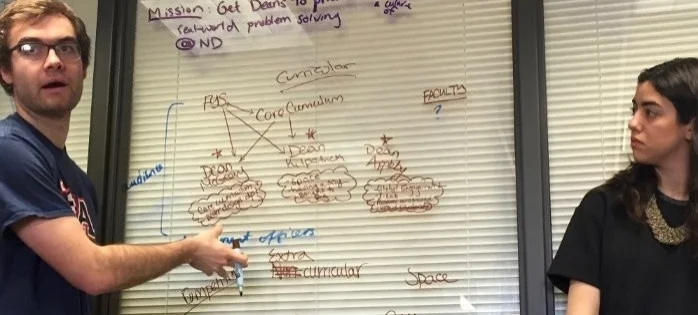How does one teach failure in a way that is not, well, simply another version of success?
This is the challenge our group faced as we embarked on what was, for most of us, our first foray into a formalized teaching role. As students of the International Development and Design Thinking course, groups of two or three were tasked with designing and facilitating a course related to some aspect of design thinking.
The choice of topic came easily. Within the process of design thinking there are many aspects that circle around the idea of failure without ever addressing its role in the design thinking process head on. A discussion of growth mindsets might lead one to conclude that all we really need to know about failure is how to bounce back from it.
The concept of prototyping might beg the question of what, if anything, is truly a failure if you simply consider it a prototype of the next, more successful iteration. These are certainly optimistic ways to think about failure, but we wondered if they were helpful in practice.
While the what of our teaching assignment came pretty quickly, the how proved more difficult.
Discussing failure in a way that doesn’t come off as trite or impractically idealistic is a challenge. A TED talk by entrepreneur Jagi Jill provided the shape of the central message of our lesson. Jill discusses the evolution of the entrepreneurial and design thinking-centered approaches towards failure- from “fail fast” to “fail better” and, most recently, “fail forward, ” acknowledging that “we don’t wake up thinking that we’re going to embrace or strive for failure.”[1]
Malcolm Gladwell’s “The Gift of Doubt,” provided an excellent introduction to the fear of failure that has long been considered a hindrance to creativity. This idea of doubt as a creative motivator served as the basis for our class discussion. Judging by the responses to the reflection questions concerning the student’s own views and insights gained from Gladwell’s essay, was a concept that our classmates found both fresh and pertinent to the study of international development and our Development Advisory Teams (DATs), semester-long development projects that serves as a central focus of the course.
We had talked about the idea of prototyping failure relatively early in our class design process> The central goal of the activity, to get the DAT teams to use the fear of failure to design their projects in a way that would deliver a more successful and robust solution to the client, flowed naturally from a discussion on Gladwell’s essay and the Hiding Hand principle posisted by its subject, Albert Hirschman, the idea that initial ignorance about the scope of a problem will force one to to find a creative solution rather than abandon a project once it is already underway.
By encouraging teammates to “prototype failure” through the facilitation of a frank discussion among DAT team members concerning their biggest concerns or doubts surrounding the project, and then asking them to use these insights to work as a team to find way to mitigate the likelihood of such events, team members were provided a platform to be frank about their own doubts about the DAT projects and the directions they’re moving in without assigning blame to one another. This is also a simple yet effective activity that can be translated to any number of projects that a classmate undertakes in the future.
In an attempt to teach failure in a way that stuck, our group connectedto a guiding principle of design thinking: empathy. As a student, future employee, and DAT member, simply being lectured to about all the ways in which I can embrace failure is unhelpful when failure might mean, for example, standing in front of a client and realizing that you spent a semester on a deliverable that will be promptly forgotten. Instead, we focused on bringing about a substantive conversation around the use of failure and doubt as a catalyst, rather than a barrier, for creativity, and aimed to offer practical insights from successful people who have failed a lot.
I’m particularly happy that we were able to teach this class at a time when such fears concerning our DAT projects are really coming to a head, and hope that our work in designing this class is reflected in the ways that the DAT teams address their anxieties surrounding this final race towards the finish. For my team particularly, working on the expansion of Notre Dame’s presence in India, this activity allowed us to voice concerns with a particular direction in which the project was heading without casting the work of any one team member in a negative light. Within our failure brainstorming process, we were also able to identify and develop plans to mitigate the risk certain negative outcomes that we had not incorporated into our plans previously.


